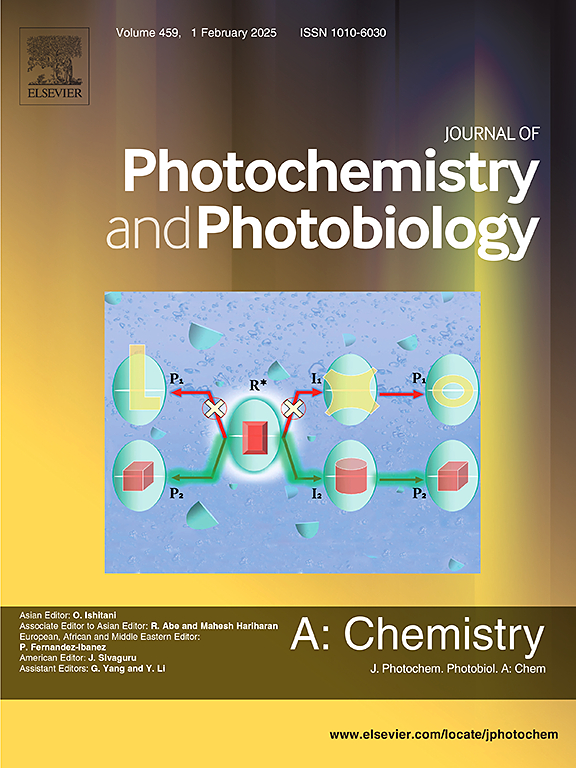Application of natural hematite as catalyst in heterogeneous photo-Fenton like process for 2,4-dichlorophenol degradation
IF 4.7
3区 化学
Q2 CHEMISTRY, PHYSICAL
Journal of Photochemistry and Photobiology A-chemistry
Pub Date : 2024-09-29
DOI:10.1016/j.jphotochem.2024.116057
引用次数: 0
Abstract
This work investigates the degradation of 2,4-dichlorophenol (2,4-DCP) through the combination of hematite and UV light for the activation of sodium percarbonate (SPC) in a heterogeneous photo-Fenton like (HPF) process. The hematite was fully characterised and the effects of different reaction parameters such as pH, doses of hematite and SPC, 2,4-DCP initial concentration, and the presence of co-existing anions were investigated. Under the optimised conditions (pH = 3.0, [Hematite]0 = 300.0 mg L−1, [SPC]0 = 500.0 mg L−1), the degradation of 2,4-DCP (50.0 mg L−1) was 99.88 ± 0.05 %. Quenching experiments demonstrated the participation of 1O2, O2![]() −, CO3
−, CO3![]() −, and
−, and ![]() OH radicals in the degradation of 2,4-DCP, with the dominance of
OH radicals in the degradation of 2,4-DCP, with the dominance of ![]() OH radicals (82.39 %). Furthermore, the degradation of 2,4-DCP was effectively retarded by the presence of Cl−, NO3−, CO32−, and PO43− anions in the solution. Overall, the HPF process with hematite can be proposed as an effective and promising approach for the degradation of 2,4-DCP from the waste stream and can be used for the decontamination of other organic compounds due to its stability and feasibility.
OH radicals (82.39 %). Furthermore, the degradation of 2,4-DCP was effectively retarded by the presence of Cl−, NO3−, CO32−, and PO43− anions in the solution. Overall, the HPF process with hematite can be proposed as an effective and promising approach for the degradation of 2,4-DCP from the waste stream and can be used for the decontamination of other organic compounds due to its stability and feasibility.

天然赤铁矿作为催化剂在类似异相光-芬顿过程中降解 2,4-二氯苯酚的应用
这项研究探讨了在类似于异相光-芬顿(HPF)的过程中,通过赤铁矿与紫外线的结合,活化过碳酸钠(SPC),从而降解 2,4-二氯苯酚(2,4-DCP)的问题。对赤铁矿进行了全面的表征,并研究了不同反应参数的影响,如 pH 值、赤铁矿和 SPC 的剂量、2,4-二氯丙醇的初始浓度以及共存阴离子的存在。在优化条件下(pH = 3.0,[赤铁矿]0 = 300.0 mg L-1,[SPC]0 = 500.0 mg L-1),2,4-DCP(50.0 mg L-1)的降解率为 99.88 ± 0.05 %。淬灭实验表明,1O2、O2-、CO3- 和 OH 自由基参与了 2,4-DCP 的降解,其中 OH 自由基占主导地位(82.39%)。此外,溶液中的 Cl-、NO3-、CO32- 和 PO43-阴离子也有效地延缓了 2,4-DCP 的降解。总之,使用赤铁矿的 HPF 工艺是降解废物流中 2,4-二氯丙醇的一种有效且有前景的方法,由于其稳定性和可行性,还可用于其他有机化合物的净化。
本文章由计算机程序翻译,如有差异,请以英文原文为准。
求助全文
约1分钟内获得全文
求助全文
来源期刊
CiteScore
7.90
自引率
7.00%
发文量
580
审稿时长
48 days
期刊介绍:
JPPA publishes the results of fundamental studies on all aspects of chemical phenomena induced by interactions between light and molecules/matter of all kinds.
All systems capable of being described at the molecular or integrated multimolecular level are appropriate for the journal. This includes all molecular chemical species as well as biomolecular, supramolecular, polymer and other macromolecular systems, as well as solid state photochemistry. In addition, the journal publishes studies of semiconductor and other photoactive organic and inorganic materials, photocatalysis (organic, inorganic, supramolecular and superconductor).
The scope includes condensed and gas phase photochemistry, as well as synchrotron radiation chemistry. A broad range of processes and techniques in photochemistry are covered such as light induced energy, electron and proton transfer; nonlinear photochemical behavior; mechanistic investigation of photochemical reactions and identification of the products of photochemical reactions; quantum yield determinations and measurements of rate constants for primary and secondary photochemical processes; steady-state and time-resolved emission, ultrafast spectroscopic methods, single molecule spectroscopy, time resolved X-ray diffraction, luminescence microscopy, and scattering spectroscopy applied to photochemistry. Papers in emerging and applied areas such as luminescent sensors, electroluminescence, solar energy conversion, atmospheric photochemistry, environmental remediation, and related photocatalytic chemistry are also welcome.

 求助内容:
求助内容: 应助结果提醒方式:
应助结果提醒方式:


